

Lilyana Nacheva-Skopalik
lilis@tugab.bg  0000-0003-4422-2767
0000-0003-4422-2767
e-Revista Internacional de la Protección Social ▶ 2022
Vol. VII ▶Nº 2 ▶ pp. 225 - 242
ISSN 2445-3269 ▶ http://dx.doi.org/10.12795/e-RIPS.2022.i02.14
Recibido: 08.06.2022 | Aceptado: 13.12.2022
|
ABSTRACT |
KEYWORDS |
|
|
Decent Work measurements and monitoring is high in the agenda of International Labour Organization (ILO). “Employment opportunities for personal and professional development” is an indicator with a high rank within accepted emerging set of Decent Work indicators. Research team begins investigation to explore this indicator within area of science and university education and involvement of women. Some examples for contribution of women in achieving girls and women education and development of education system in Bulgaria in historical periods are given. Paper presents data for proportion of women in modern Bulgarian Higher education system. Future research within Decent Work network is anticipated to collect, analyze and compare data for partner universities. |
Decent work Education Bulgaria |
|
|
RESUMEN |
PALABRAS CLAVE |
|
|
La medición y el seguimiento del trabajo decente ocupan un lugar destacado en la agenda de la Organización Internacional del Trabajo (OIT). “Oportunidades de empleo para el desarrollo personal y profesional” es un indicador con un alto rango dentro del conjunto emergente aceptado de indicadores de Trabajo Decente. El equipo de investigación comienza a explorar este indicador en el ámbito de la educación científica y universitaria y la participación de las mujeres. Se ofrecen algunos ejemplos de la contribución de las mujeres a la educación de niñas y mujeres y al desarrollo del sistema educativo en Bulgaria en periodos históricos. El documento presenta datos sobre la proporción de mujeres en el moderno sistema búlgaro de enseñanza superior. Se prevé que en el futuro la red de Trabajo Decente recopile, analice y compare los datos de las universidades asociadas. |
Trabajo digno Educación Bulgaria |
III. WOMEN IN HIGHER EDUCATION IN BULGARIA IN MODERN SOCIETY
International Labour Organization (ILO) has approved the need for Decent Work measurements and monitoring[1].
The four strategic pillars of the Decent Work Agenda are defined as: full and productive employment, fundamental rights at work, social protection and the promotion of social dialogue. Decent Work Indicators Framework adopted at the International Conference of Labor Statisticians (ICLS) in December 2008 covers ten substantive elements corresponding to these strategic pillars[2].
Ten areas are:
These elements were the starting point to define the emerging set of Decent Work indicators shown in Table 1[3].
Table 1.
Decent Work indicators
|
Indicators of Decent Work |
|
Employment opportunities for personal and professional development |
|
Adequate earnings and productive work |
|
Decent working time |
|
Environmental quality in the workplace |
|
Decision-making capacity in the workplace |
|
Decision-making capacity in the co-management of the company |
|
Combining work, family and personal life |
|
Work that involves antisocial, antihuman and criminal activities |
|
Stability and security of work |
|
Equal opportunity and treatment in employment |
|
Social dialogue, employers ‘and workers’ representation |
|
Social security |
Initial experience in research for evaluation of Decent Work up to now shows that exploring the whole set of indicator appears to be a research topic of a great scale [DW 2018]. In order to reduce area of study and data collection each individual indicator for different professional areas can be investigated separately. Go further, research for a general evaluation for this complex and multifaceted question is a next step.
During a pilot investigation the importance of the chosen indicators was evaluated using an approach for objective evaluation of subjective opinions. Inquiries among university lecturers and students showed that “Employment opportunities for personal and professional development” indicator is with a high rank –second and third respectively for the mentioned enquiries–[4].
Since research team work at university it is reasonable to begin research on this indicator in the area of science and university education, having personal professional experience. Furthermore, academic staff varies in terms of professional area, age, and academic level etc. Having female colleagues and also colleagues with different origins different examples of situations which cause stress or happiness at the workplace are observed. One natural question which needs an answer is if there is something like a female perception of what Decent Work should be.
Investigation for university employment opportunities and not only access but also professional promotion is the basis to analyze if there are visible or invisible obstacles for women and men. Questionnaires can check and visualize social and legal problems to achieve the idea of Decent Work in different Universities and also can give options to learn from good practices. A starting point can be some results from national surveys and official statistical information about women and men at Universities. This paper presents the first step in research work on this area within Decent Work research team. Various future research for partner universities are anticipated. Analysis of collected data, their comparison and summarizing would lead to needed answers.
Before discussing available statistical data for current stage some information for the past times is given below. The goal is not to present a full historical review for women working in science and university education. The idea is with some strong examples of remarkable persons to give an indication of the significant steps in the process of achieving girls and women education, further professional development and contribution of educated women as teachers at school and university and scientists in the conditions of complicated and multifaceted historical periods.
In the period from the end of the 14th to the end of the 19th century there was no independent Bulgarian state. Тhe lands inhabited by Bulgarians were under the control of the Ottoman Empire which established a harsh order in the conquered lands. If a man is to be educated, to understand commerce, to engage in crafts, government or war, then women’s opportunities are seen in terms of being able to rotate, maintain a home, and care for children and regarded as second-hand. Under the laws of the Ottoman Empire girls are forbidden to be literate with boys.
At the beginning of the 18th century, new educational needs for girls have been felt. A strong impulse for enlightenment is given by Renaissance and Enlightenment ideas. Emergence of national consciousness plays an important role for the process of spiritual awakening. The educational revolution among the Bulgarians during the Renaissance is as significant as the subsequent struggle for political liberation, remarkable with heroism, self-denial and sacrifice of its participants. Taking into account the fact that it is not realized due to a purposeful state policy, and more precisely despite the lack of a Bulgarian state and an independent Bulgarian exarchate, educational revolution becomes one of the unique and greatest episodes of Bulgarian history. One of the most valuable assets of the Bulgarian Revival period is education. Nowadays, if it is universal, accessible and easily achievable, it was unbearable during that unsecured era.
The emergence of the first girls’ schools came about naturally, as a result of social processes. The first girls’ schools are housed in women’s monasteries and private homes, so called cellular schools. Teachers were nuns, women and daughters of cellular teachers, but occasionally the rule is broken and there are some male teachers. The content, organization and teaching methods were identical to those of the men’s cellular schools. The first known name of a cellular teacher is Hadji Trendafila, whose husband is a teacher in Sliven[5].
Among the first cellular schools to open doors were in Kotel and Svishtov (1820), Gabrovo (1825), Teteven and Shumen (1828). In spite the inherent naivety regarding the organization of the learning process, they are the spiritual pillar upon which the first truly secular girls’ schools were founded.
The unenlightened darkness for the Bulgarian girls ended in 1840, when a young woman, Anastasia Dimitrova, managed to make one of the major revolutions in Bulgarian education, namely to open the first secular girls’ school in Pleven[6] The school gave equal rights and opportunities with the use of the mutual teaching method and trained students who would then continue her holy cause. Anastasia Dimitrova was born on May 12, 1815 in Pleven. A child of poor parents, her mother is a maid in the home of Bishop Agapi of Vrachna. She first studied with her benefactor, the bishop’s mother. Later she continued her education at the Kalofer Virgin Monastery (1836-1839). She studies not only with nuns, but also with teachers like Botyo Petkov, Rayno Popovich, Bryko Genovich. She studies history, geography, arithmetic, grammar. The first secular girls’ school in Pleven (1840) was funded by Bishop Agapiy. Her students also learn Greek. In 1845, about 90 girls from Pleven, Lovech, Troyan, Turnovo, Vratsa and others studied with Anastasia Dimitrova. The schoolgirls become teachers or open new mutual schools, such as in Panagyurishte and Vratsa (in 1842 and in 1843), and in some other places like Svishtov and Lovech. In 1856, the first Bulgarian class girls’ school was opened in Shumen.
Anastasia Tosheva was born on 18 January 1837 in Eski Zaara, now Stara Zagora[7]. She initially studied in her hometown (1846-1848) and at Kalofer Monastery (1849). In 1850 Z. Knyazheski takes Anastasia to Mrs. Vasilyova’s school boarding house. She is the first Bulgarian girl who has been sent to study in Odessa funded by money, collected by charity. She received her education at the Pedagogical Institute from 1850 to 1857 becoming first Bulgarian women teacher with pedagogical education degree. In 1857 she returned to her hometown and opened a Primary Girl’s School under the Monastery Church “St. Dimitar”, in which she taught until 1858. In 1863-1870 she taught at the class girl’s school in Stara Zagora. From 1870 to 1876 she was the head teacher at the girls’ school in Gabrovo and manager of the boarding house. Anastasha (as she was called in Gabrovo) has taught many prominent Bulgarian women with historical merits - Raina Popgeorgieva (Raina Knyaginya), V. Pishurkova (daughter of Krustyo Pishurka), Vela Blagoeva and others. Anastasia Tosheva outlines her views on girls’ education and upbringing in the article “Encouraging Bulgarian women to progress” (1870). She advises women to fight for more science to catch up with educated women in Europe. Anastasia Tosheva develops active social activity - holds public lectures, organizes women’s societies in Stara Zagora and Gabrovo. During the Russian-Turkish War of Liberation (1877 - 1878) she worked as a nurse in Tarnovo. On July 10, 1877, Anastasia Tosheva hold a speech welcoming the army of Gen. Gurko in Veliko Tarnovo. Between 1878 and 1892 she taught in Gabrovo. In Stara Zagora, in addition to teaching, she became the director of the newly opened girls’ high school and the manager of the school boarding house. She translates books from Russian and French into Bulgarian. She found eternal rest in February 1919.
The development of the women’s movement in Bulgaria began even before the Liberation of Bulgaria, from the middle of the 19th century. The first women’s association was founded in 1857 in the town of Lom by teacher Krastio Pishurka, followed by establishment of women associations in other cities in the country.
With the peace pact from 03.03.1878 the Russian-Turkish war ended. This war is called war of liberation for Bulgarians, followed by steps for restoring of the Bulgarian state. The Unification of Bulgaria, which was an act of unification of the Principality of Bulgaria and the province of Eastern Rumelia, happened on 06.09.1885. Independence of Bulgaria from the Ottoman Empire, The de jure, was proclaimed on 22 September 1908. At this period the foundations of the modern European state were developed.
At the end of 1899, 11 years after the Russian-Turkish war of liberation, the publication of the “Female Voice” newspaper began. At their national conference on July 10 - 14, 1901 the regional women’s clubs united into a national organization - Bulgarian Women’s Union. The first president of the BSC is Ekaterina Karavelova[8]. The goals of the union are “to mentally and morally elevate a woman and improve her situation in every way”.
Tarnovo Constitution, the first constitution after liberation which was in power on 16.04.1879, says that all Bulgarian citizens have to pay taxes. The interpretation of this article is put into circulation and they pay. However, when Tarnovo Constitution states that all Bulgarian citizens over a certain age are voters, the interpreters, who are also its creators, do not allow women to vote. And it took decades to ask this question, women had to insist for their rights. Women were first allowed in the local and parliamentary elections in 1937 and 1938.
In addition to the political vote, women fight for equal rights in the field of education. The state creates many more high schools for men than girls. This immediately entailed the inability of women to study at Sofia University. Sofia University was established in 1888 and it was not until 1901 that women were first allowed to study in it. The opinion of those in power is that they are not sufficiently educated. At the same time the state deprives women of education by not creating adequate educational institutions for them. Some of the reasons are rooting in tradition. The traditional view for men and women is that women are private and men are public beings. Women should stay home and look after their children, family, while men should earn a living.
Bulgarian women entered science at the end of the First World War. Their admission to the University of Sofia and several scientific institutions such as National Ethnographic and National Archaeological Museum, is accompanied by apparent segregation. A survey of assistants in various faculties of Sofia University, made in the late 1930s, made it clear that “in Bulgaria, the disposition of science is still a monopoly of the man and the admission of the woman [...] becomes personal at her will,” and the prevailing stereotype is that a woman engages in the science of “megalomania or temporary entertainment until she is married and has a child”.
The first female lecturer at a Bulgarian university and the first female scientist in Bulgaria is the chemist Teodora Raykova[9]. Teodora Raykova was born in 1893 in Sofia. Her father is Prof. Pencho Raykov, founder of the Department of Chemistry at Sofia University. In 1918, two years after completing chemistry at Sofia University, age 25, Theodora was appointed assistant to her father at the Faculty of Physics and Mathematics. Thus she became the first female assistant professor at a Bulgarian university. She had her first scientific publication even before her appointment. In 1917 Raikova published her research on the reducing effect of chloroform on the Felling reagent, which binds to the formation of carbon dioxide, in the specialized German magazine. This is only the second scientific paper on chemistry of a graduate of Sofia University.
The first scientific paper of a woman student at Sofia University is from 1906 by Evgeniya Yurkevich, with whom Prof. Pencho Raykov works on the detection and determination of nitrotoluene in nitrobenzene and toluene in benzene, published in Chemiker Zeitung, №27, 1906. Evgeniya Yurkevich was born on 08.04.1879 in Svishtov. She was the first female student graduated chemistry in 1904/1905[10]
Raykova specialized in Germany (1922) and Austria (1931) and published in the leading German scientific publications Zeitschrift für analytische Chemie and Deutsche Chemische Geselschaft (1929-1931), participated in the founding of the Sofia Chemical Society, was elected to the leadership of the Union of Chemists and is a delegate to their congresses. She is a long-time editor of “Chemistry and Industry magazine”. In 1918, Teodora Raykova proposed an original method for the detection of strontium in the presence of barium by gypsum solution, and in 1928 –the first color reaction to recognize American from Russian and Romanian oil–.
Although professors like Assen Zlatarov support women’s scientific careers at Sofia University, the majority of the academic staff is in a completely opposite position. In October 1924, the Academic Council amended the Assistant Regulations to allow the appointment of women at Sofia University only if there were no male candidates for the post. This policy has been maintained for at least 10 years and applies to the recruitment or renewal of contracts for faculty members, including Raikova. In 1926, Raykova published the first “Short Guide to Preparative Organic Chemistry”. Teodora’s independent research also presents her as the first woman scientist in Bulgaria.
Theodora’s successful career proves to be insufficient to secure her academic position and attempts are repeatedly made to terminate her contract on the pretext that she is the daughter of the head of the department. Even the excellent reviews of German professors about her research, which, in their opinion, “go far beyond the requirements of an assistant,” as well as their admiration for Theodora’s “remarkable scientific works” (according to Prof. Bush from Erlangen, would “honor and to any professor of chemistry”), they do not help her maintain her teaching position. Thus, in 1932, the contracts of Teodora and other assistants were canceled.
Depriving her of the opportunity to teach does not stop her from studying science. Theodora established her own laboratory for perfumery and cosmetics, where she combined experimental work with the pursuit of the profession. The laboratory was nationalized in 1944. Following the coup d’état of September 9th, 1944, Theodora hopes to be able to regain her position at Sofia University, since the leadership that terminated her contract was removed. However, this does not happen. Her application for academy at Bulgarian Academy of sciences (BAS) was unsuccessful. She also failed at the competition for a senior research fellow at the Institute of Chemistry at BAS in 1952.
For the rest of her life, Teodora Raykova is engaged in her favorite science outside the official institutions. Her research in the field of stereochemistry of oximes has aroused interest in specialized foreign press, as she is the only Bulgarian name cited in Paul Walden’s review of organic chemistry. In 1955, her name was once again entered in the register of rationalizations of the so called that time Institute of Rationalization (today’s Patent Office), which was working to create uniform standards in the industry –this time with a new method of destroying chrysalis–. She passed away in 1963 in Sofia.
Elisaveta Karamikhailova is the Nuclear Lady of Bulgaria[11]. Elisaveta Karamikhailova was born in 1897 in Vienna. Her mother, Mary Slade, is English-born and her father is Bulgarian. However, Elizabeth’s family had to move to Bulgaria when her father, Dr. Ivan Karamikhailov, was appointed head of the Red Cross Hospital (today Pirogov hospital). From her parents, Elisaveta inherits patriotism, kindness and optimism. The young girl manifests the humanism she was brought up to help with her mother and sister during the Balkans and World War I, in which her father was a volunteer doctor. Elisaveta Karamikhailova is a graduate in physics of the University of Vienna –one of the most reputable institutions of higher education at the time–. The studies of the talented Bulgarian woman at the Radium Institute are mainly focused on gamma rays and the impact they have. She is also involved in the study of radioluminescence and radiophotoluminescence, which will contribute to the process of establishing the radiation that organisms receive over a period of time. Transmutation, i.e. the transformation of a chemical element into another as a result of a nuclear reaction is another branch of science to which Bulgarian attention is drawn. Her academic development does not stop here –she was later awarded a PhD–. Dr. Karamikhilova worked on large-scale study in 1931, conducted with the Austrian physicist Marieta Blau, which proved crucial for another revolutionary achievement –the discovery of a neutron, for which James Chadwick was even awarded the Nobel Prize –. During her stay in the Austrian capital, Dr. Karamikhailova also joined the International Society of Higher Education Women. She continues her scholarly career at the prestigious University of Cambridge, England, for which she received a scholarship. She works at the Cavendish Lab at the university, whose head was then the founder of nuclear physics, Lord Ernest Rutherford. There, she has the opportunity to collaborate with distinguished global names in the scientific world. At that time, Dr. Karamikhailova became acquainted with another area of this science –nuclear spectroscopy (part of nuclear physics, studying the properties of nuclear energy levels)–.
Despite the many perspectives and remarkable scientific activity in Europe, the Bulgarian genius of nuclear physics chooses to continue working in her homeland. She stubbornly follows this desire. After two refusals she receives when applying for a teaching position in the country, in 1939 she was already appointed an Assistant Professor. Elisaveta Karamikhailova founded and headed the Department of Atomic Physics at the Faculty of Physics of Sofia University “St. Kliment Ohridski “, where she became the first woman - habilitated teacher. In addition to bringing her own equipment and introducing hand-made equipment, she brings modern standards and training fields, as well as habits of the European way of life. She continues to work as a Principal at the Institute of Physics at the Bulgarian Academy of Sciences (BAS), where her focus is on radioactivity in nature. She also received the scientific title of Professor. At the end of her life, she donates all her property to the Bulgarian Academy of Sciences and donates her body for scientific purposes. The intangible heritage that Prof. Karamikhailova leaves behind is invaluable –dozens of scientific studies and incredible knowledge, which she passes on to her students and young Bulgarian scholars with the same dedication–.
National Statistical Institute (NSI) of Bulgaria[12] produces and provides to all user groups high quality statistical products and services, produced based on harmonized European methodologies and standards and observes the principles of the European Statistics Code of Practice. The official statistical information is intended for analyses and scientific studies, planning, prognosis and making managerial decisions at micro and macro level. Data for Bulgaria. Higher education institutions presented in this paper are taken from the official website of NSI.
There are two major groups in education, which are integral part of one process –students and teachers–. In order to have a full picture, discussing women involvement in university education it is necessary to have information for both students and teaching staff. In fact, students, future university graduates, are future specialist in all areas, including profession of university lecturer. Therefore the proportion of women and men students is one indication for the future proportion at the labour market for people with university education.
In Table 2. and at Fig. 1. to Fig. 5. are presented data, taken from NSI[13].
Table 2.
Graduates tertiary education
|
GRADUATES TERTIARY EDUCATION BY EDUCATIONAL QUALIFICATION, DEGREE AND SEX |
|||||
|
(Number) |
|||||
|
2015 |
2016 |
2017 |
2018 |
2019 |
|
|
Total |
62 718 |
60 383 |
56 851 |
54 480 |
51 464 |
|
of which: female |
37 717 |
36 961 |
34 506 |
32 801 |
30 962 |
|
60% |
61% |
61% |
60% |
60% |
|
|
Professional bachelor |
2 535 |
2 418 |
2 175 |
1 869 |
1 843 |
|
of which: female |
1 408 |
1 380 |
1 248 |
1 104 |
1 122 |
|
56% |
57% |
57% |
59% |
61% |
|
|
Bachelor |
31 623 |
30 895 |
28 926 |
27 831 |
25 807 |
|
of which: female |
18 346 |
18 370 |
17 012 |
16 343 |
14 907 |
|
58% |
59% |
59% |
59% |
58% |
|
|
Master |
27 118 |
25 606 |
24 327 |
23 415 |
22 529 |
|
of which: female |
17 244 |
16 438 |
15 486 |
14 629 |
14 212 |
|
64% |
64% |
64% |
62% |
63% |
|
|
Doctor |
1 442 |
1 464 |
1 423 |
1 365 |
1 285 |
|
of which: female |
719 |
773 |
760 |
725 |
721 |
|
50% |
53% |
53% |
53% |
56% |
|
Numbers clearly show that percentage of female students is sustainably higher that parentage of male students. This applies for the total number of graduates and for different educational degrees.
Figure 1.
Graduates tertiary education
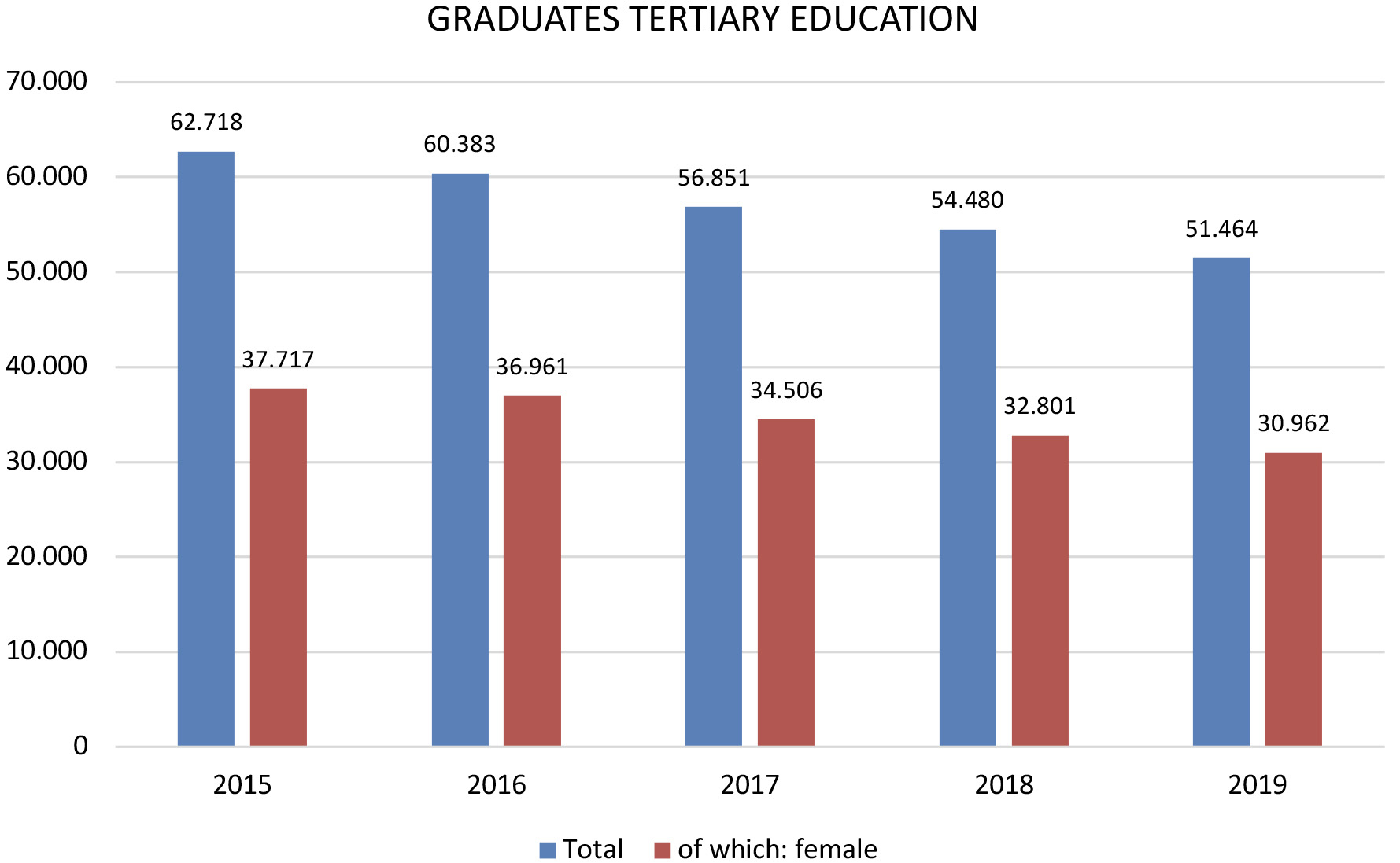
Figure 2.
Graduates – professional bachelor
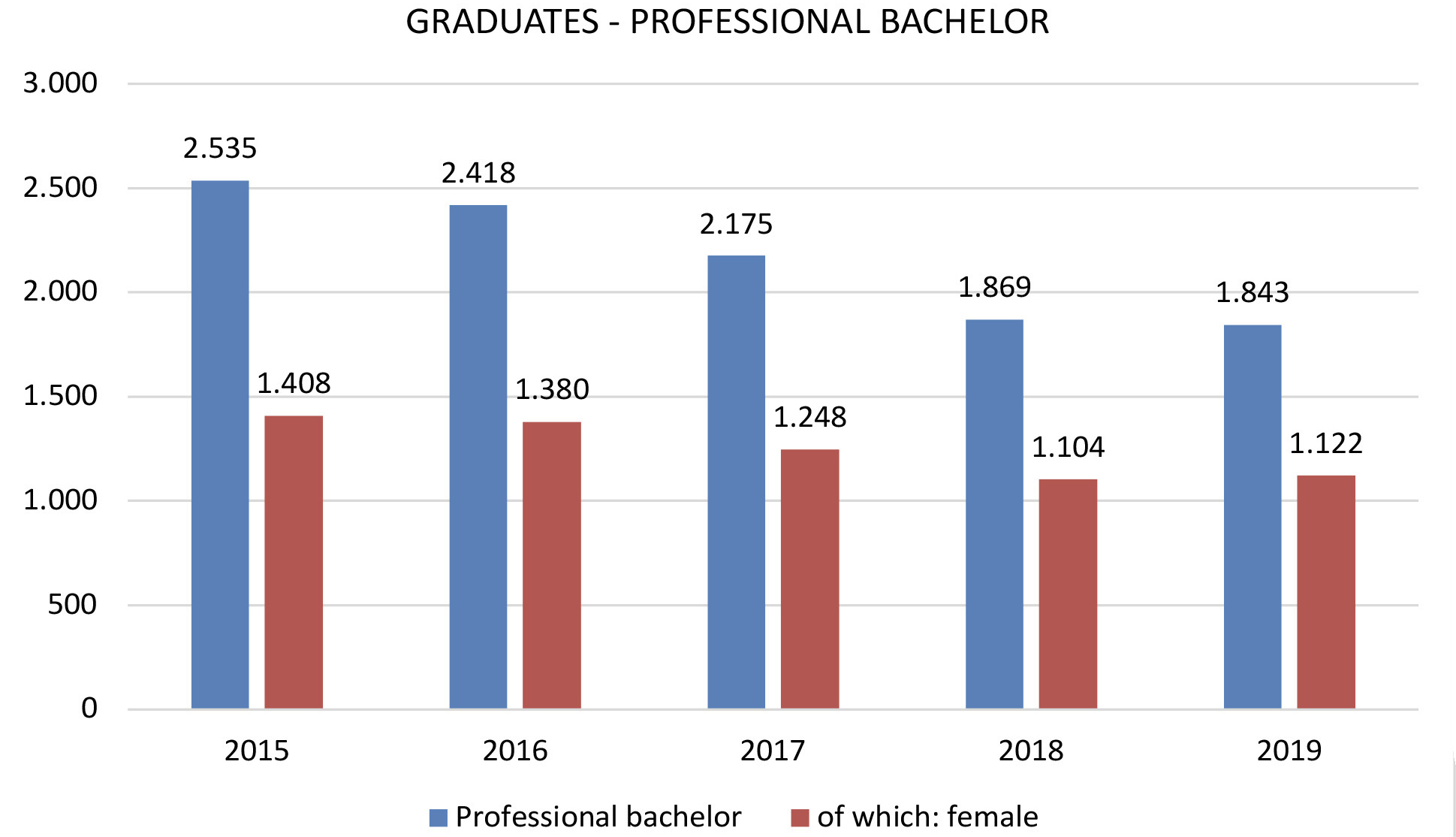
Figure 3.
Graduates – bachelor
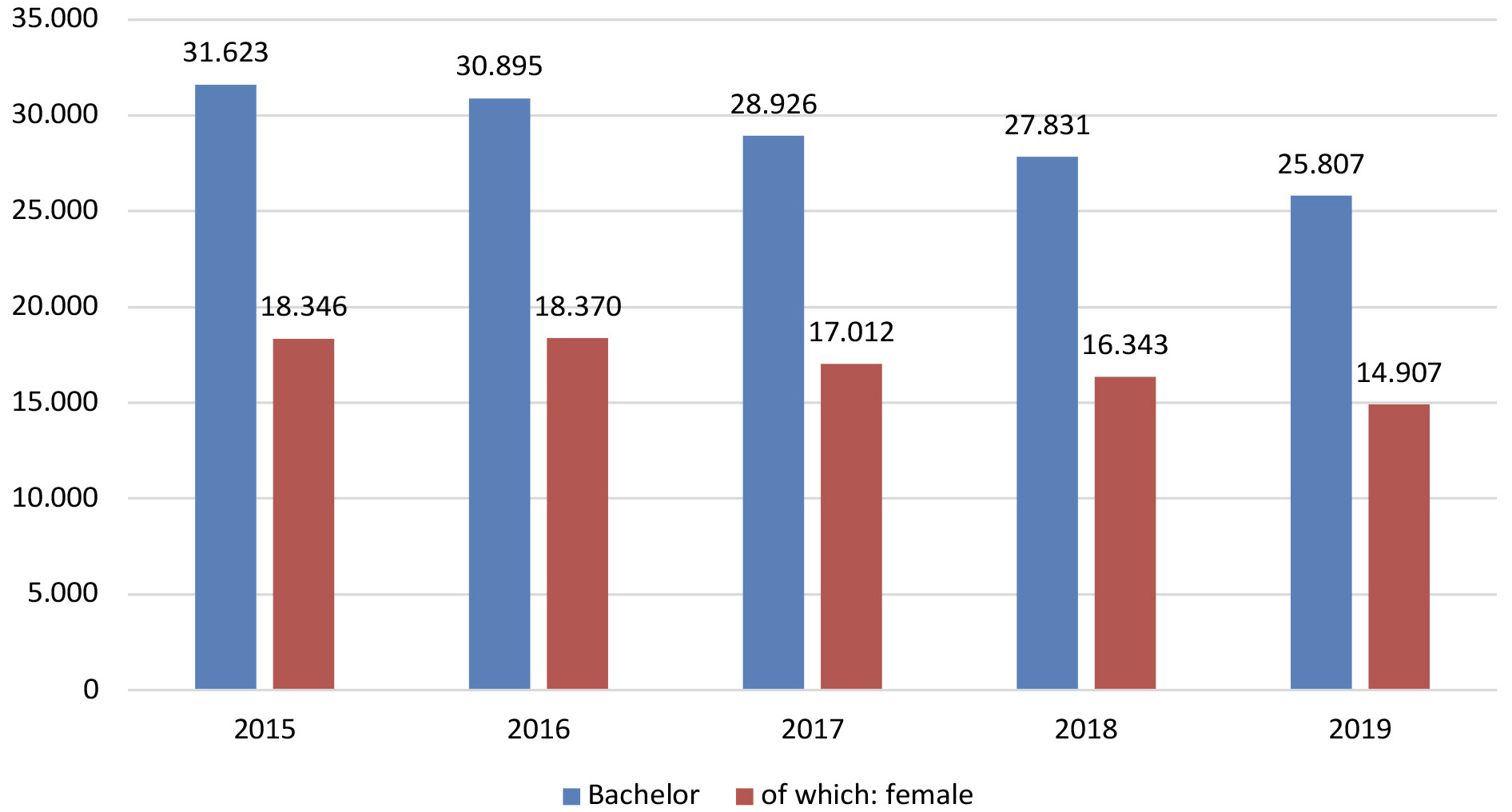
Figure 4.
Graduates – master
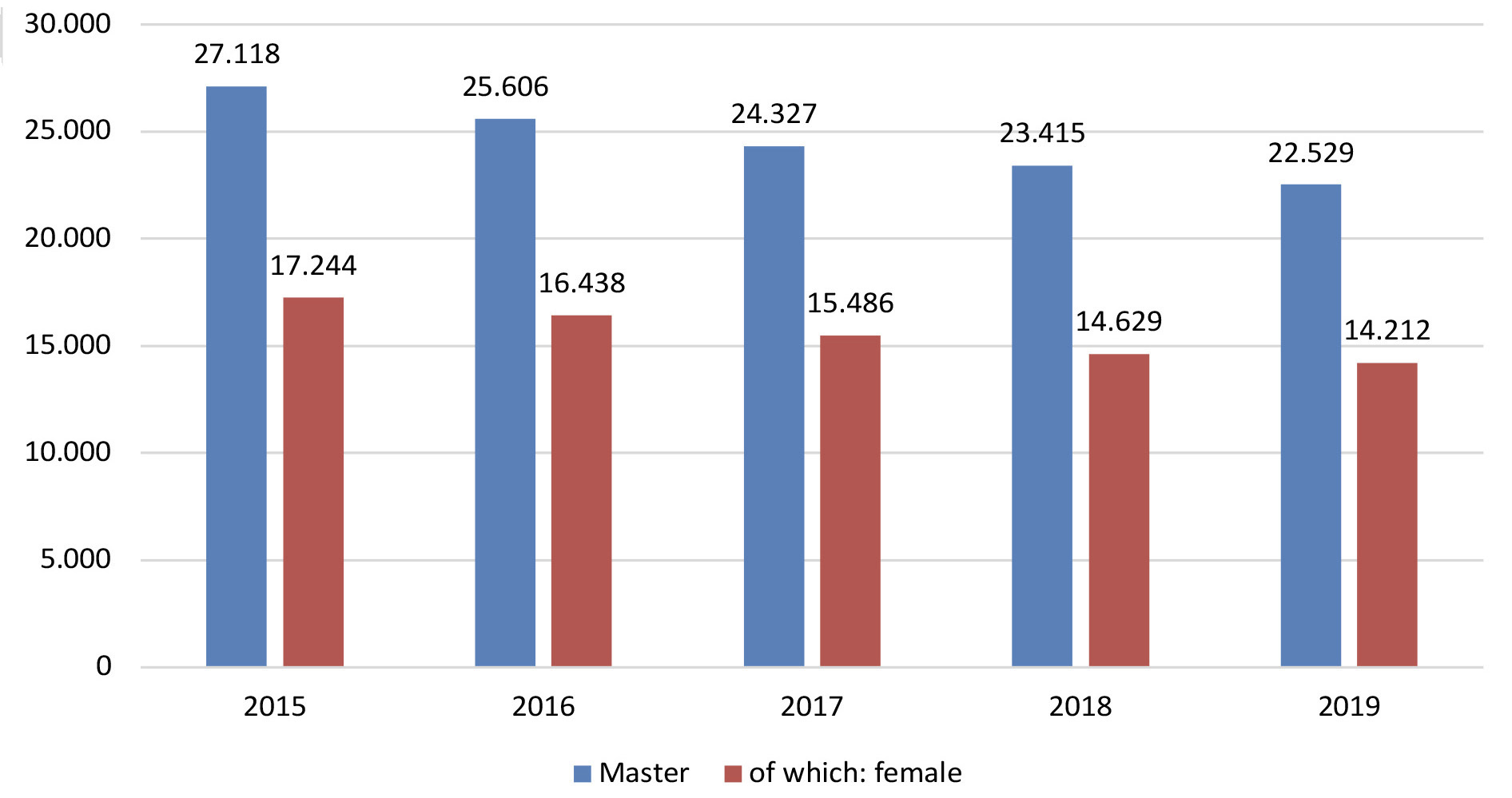
Figure 5.
Graduates – doctor
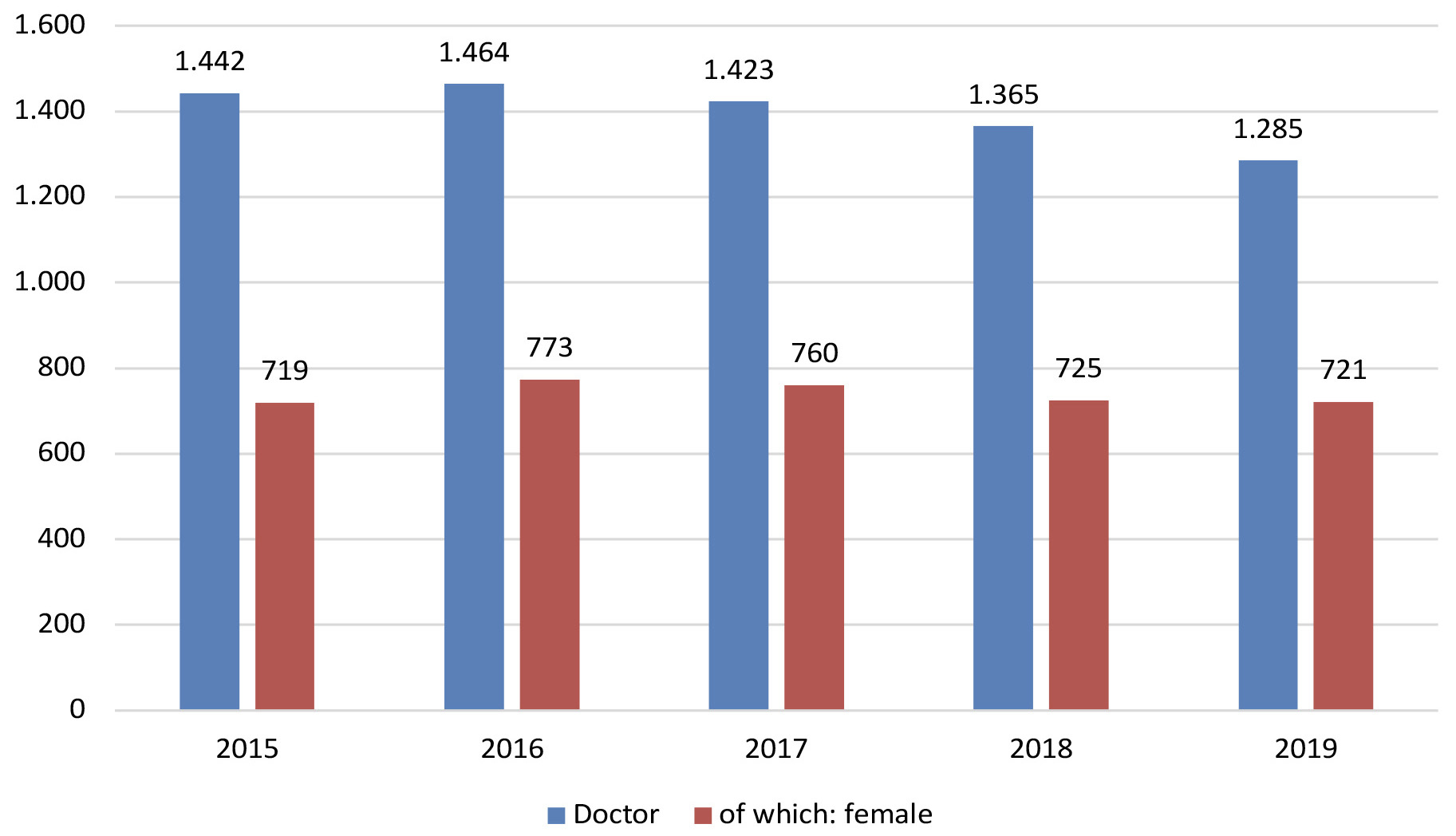
Statistica data for teaching staff at universities, both public and state, taken from NSI[14], are given at Table 3 and at Figures 6 to 11. Data present number and percentage of female teaching staff – total and by academic position. Another important characteristic is the number (percentage) of academic staff under labour contract.
Table 3.
Teaching staff in public and private higher schools
|
TEACHING STAFF IN PUBLIC AND PRIVATE HIGHER SCHOOLS - BY POSITION, SEX, KIND OF EMPLOYMENT |
|||||
|
2015/16 |
2016/17 |
2017/18 |
2018/19 |
2019/20 |
|
|
Total |
22 604 |
22 223 |
21 914 |
21 756 |
20 894 |
|
of which: female |
11 061 |
10 919 |
10 858 |
10 934 |
10 554 |
|
49% |
49% |
50% |
50% |
51% |
|
|
Professors |
3 390 |
3 378 |
3 400 |
3 416 |
3 191 |
|
of which: female |
1 151 |
1 236 |
1 299 |
1 356 |
1 271 |
|
34% |
37% |
38% |
40% |
40% |
|
|
Associate professors |
6 469 |
6 312 |
6 283 |
6 187 |
5 878 |
|
of which: female |
2 884 |
2 884 |
2 902 |
2 905 |
2 798 |
|
45% |
46% |
46% |
47% |
48% |
|
|
Assistants |
8 705 |
8 674 |
8 616 |
8 548 |
7 995 |
|
of which: female |
4 539 |
4 500 |
4 549 |
4 528 |
4 194 |
|
52% |
52% |
53% |
53% |
52% |
|
|
Lecturers |
4 030 |
3 848 |
3 609 |
3 558 |
3 769 |
|
of which: female |
2 479 |
2 290 |
2 104 |
2 120 |
2 253 |
|
62% |
60% |
58% |
60% |
60% |
|
|
Researchers |
10 |
11 |
6 |
47 |
61 |
|
of which: female |
8 |
9 |
4 |
25 |
38 |
|
80% |
82% |
67% |
53% |
62% |
|
|
Total under labour contract |
14 100 |
13 862 |
13 569 |
13 488 |
13 036 |
|
of which: female under labour contract |
7 147 |
7 100 |
7 056 |
7 025 |
6 824 |
|
51% |
51% |
52% |
52% |
52% |
|
|
Professors under labour contract |
2 066 |
2 106 |
2 032 |
2 092 |
1 945 |
|
of which: female under labour contract |
754 |
811 |
817 |
864 |
801 |
|
36% |
39% |
40% |
41% |
41% |
|
|
Associate professors under labour contract |
4 557 |
4 522 |
4 491 |
4 474 |
4 371 |
|
of which: female under labour contract |
2 144 |
2 159 |
2 197 |
2 187 |
2 154 |
|
47% |
48% |
49% |
49% |
49% |
|
|
Assistants under labour contract |
6 327 |
6 102 |
5 952 |
5 789 |
5 582 |
|
of which: female under labour contract |
3 422 |
3 333 |
3 258 |
3 170 |
3 073 |
|
54% |
55% |
55% |
55% |
55% |
|
|
Lecturers under labour contract |
1 140 |
1 121 |
1 088 |
1 086 |
1 077 |
|
of which: female under labour contract |
819 |
788 |
780 |
779 |
758 |
|
72% |
70% |
72% |
72% |
70% |
|
|
Researchers under labour contract |
10 |
11 |
6 |
47 |
61 |
|
of which: female under labour contract |
8 |
9 |
4 |
25 |
38 |
|
80% |
82% |
67% |
53% |
62% |
|
For total number of teaching staff percentage of female academics vary between 49% and 51%. Smaller proportion of females is for professors, between 34% and 40%. Higher proportion is for female researchers, between 53% and 80%. Similar proportion is for these categories under labour contract. Detailed graphical presentation is given following figures, from Fig. 6. To Fig. 11.
Figure 6.
Teaching staff in public and private higher schools
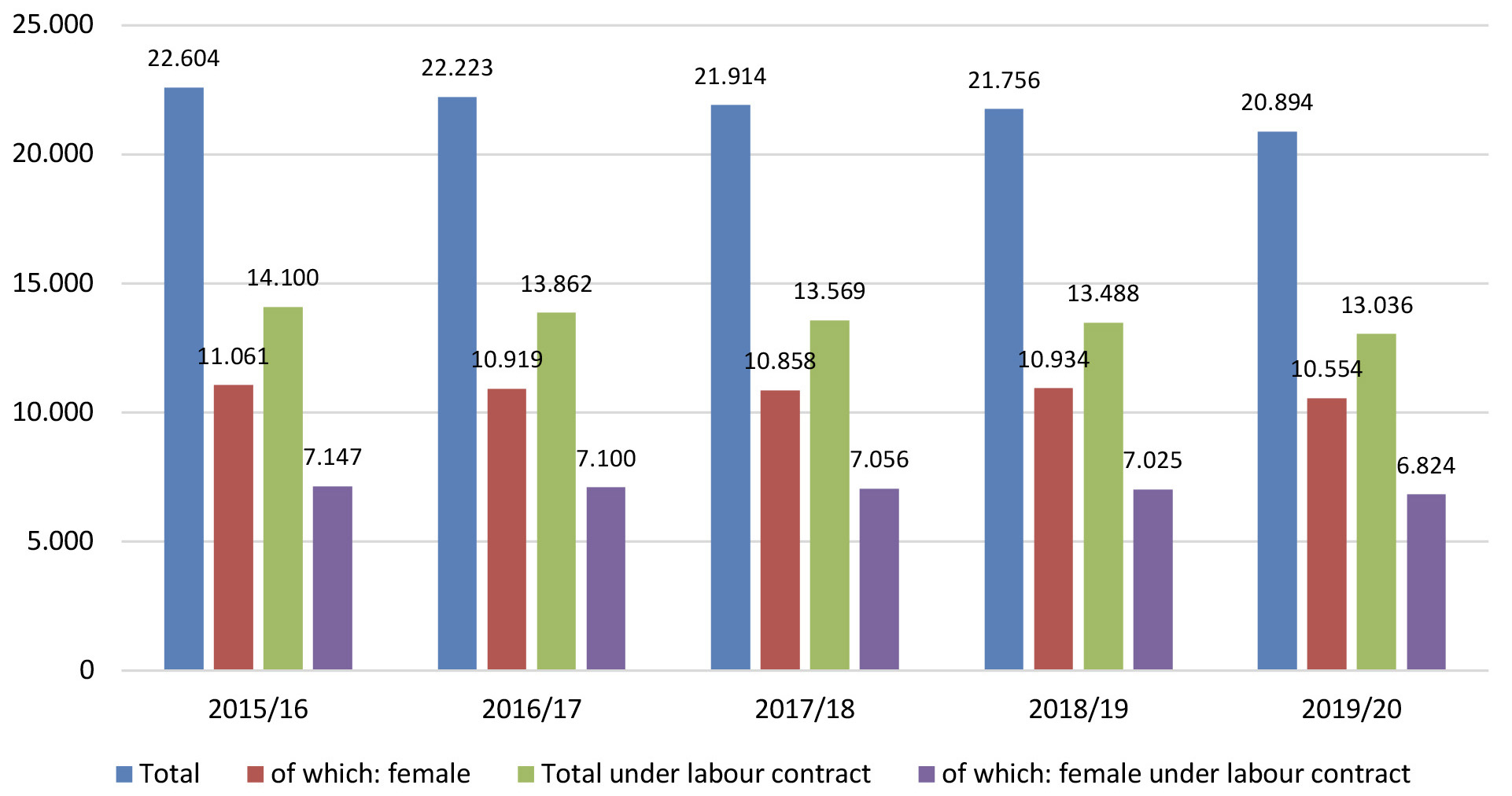
Figure 7.
Professors in public and private higher schools
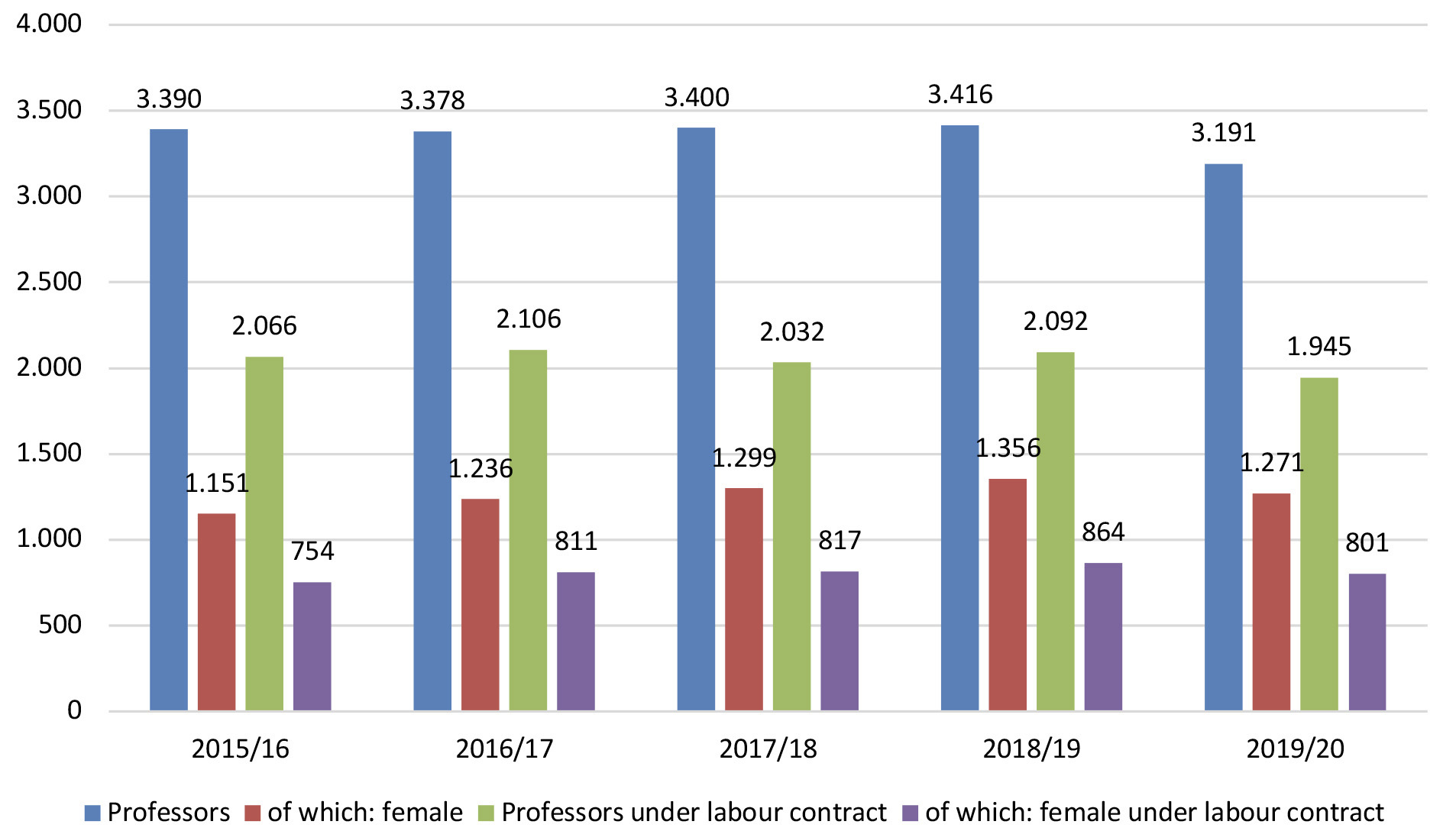
Figure 8.
Associate professors in public and private higher schools
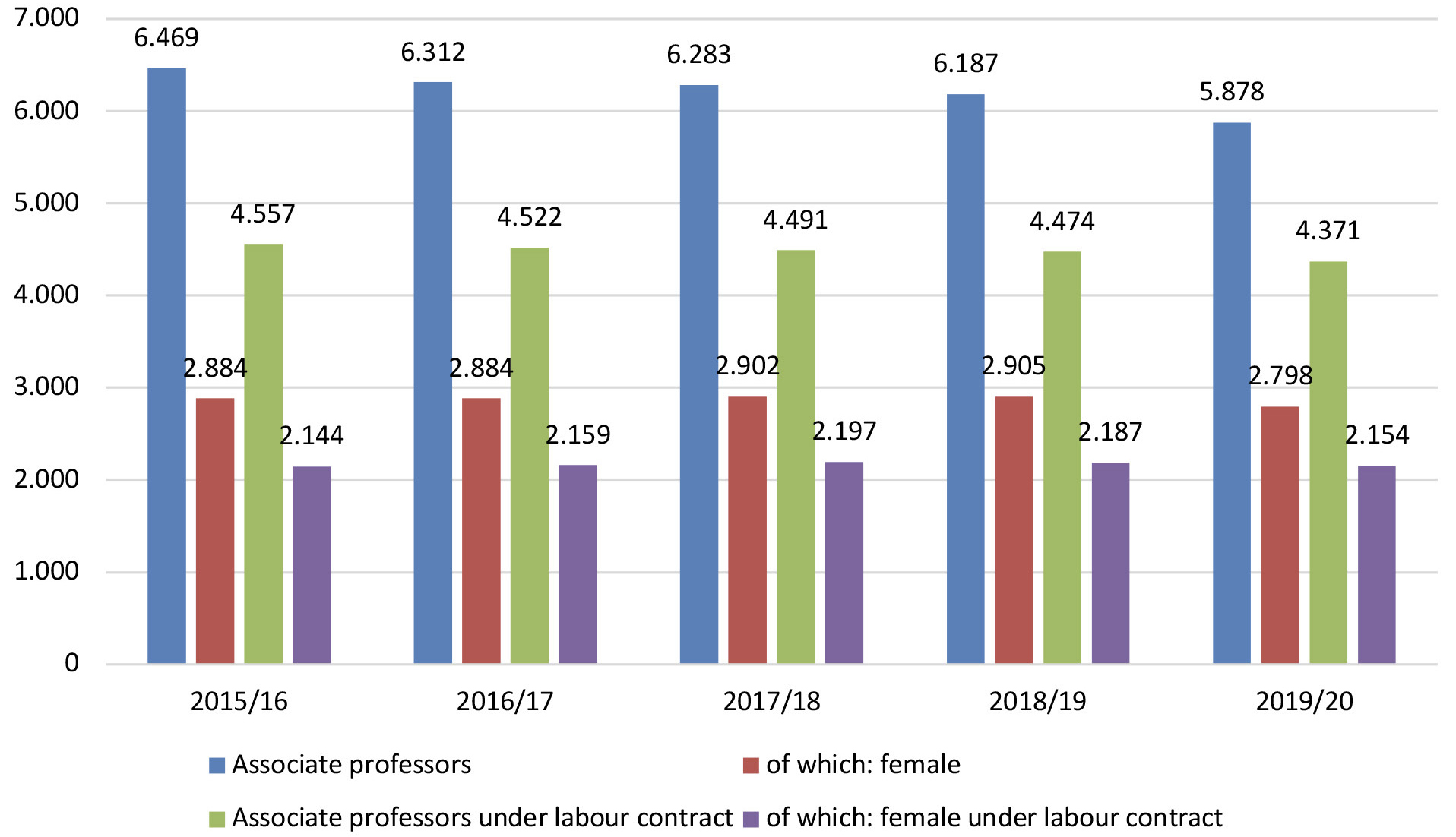
Figure 9.
Assistants in public and private higher schools
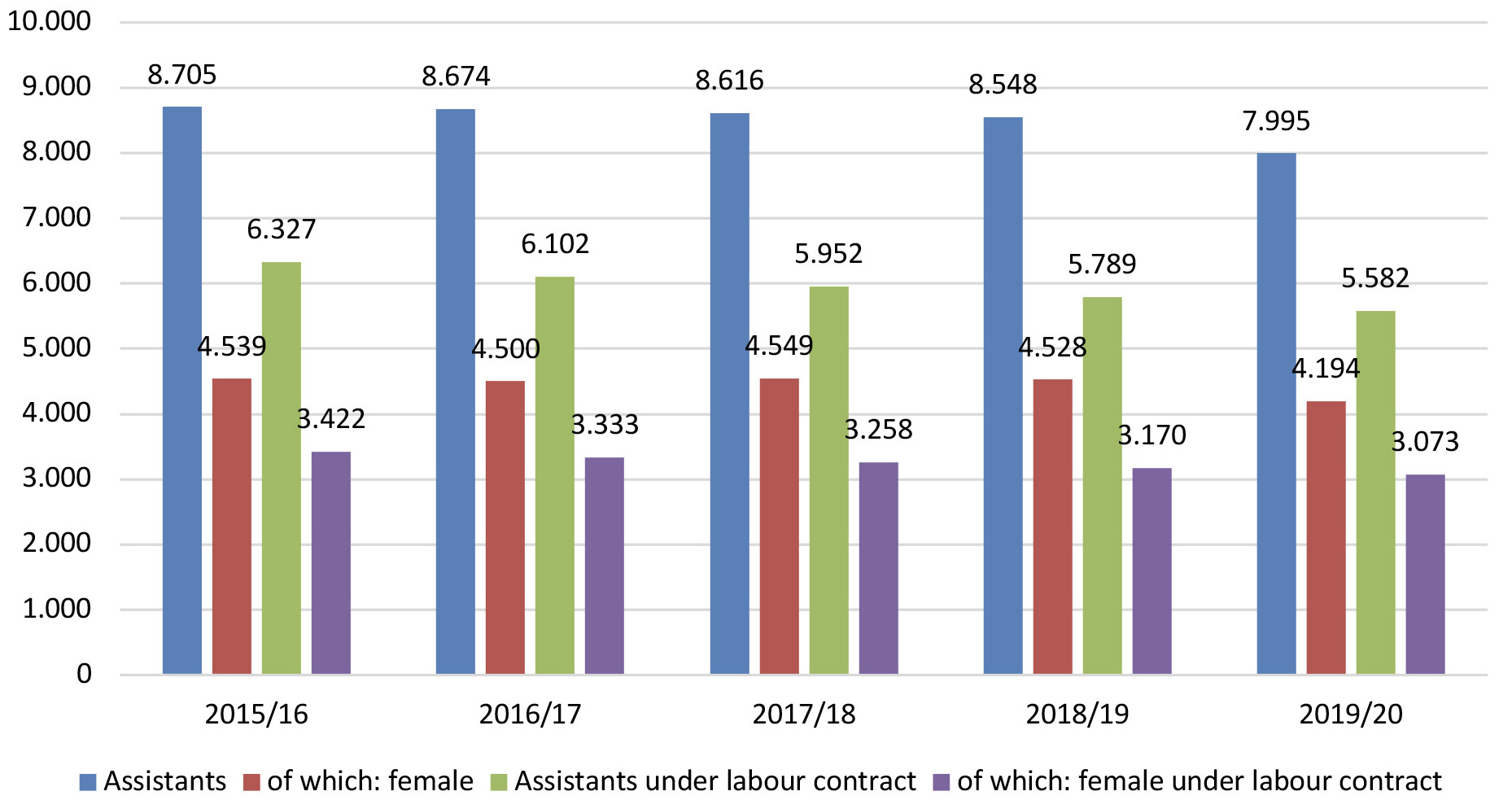
Figure 10.
Lecturers in public and private higher schools
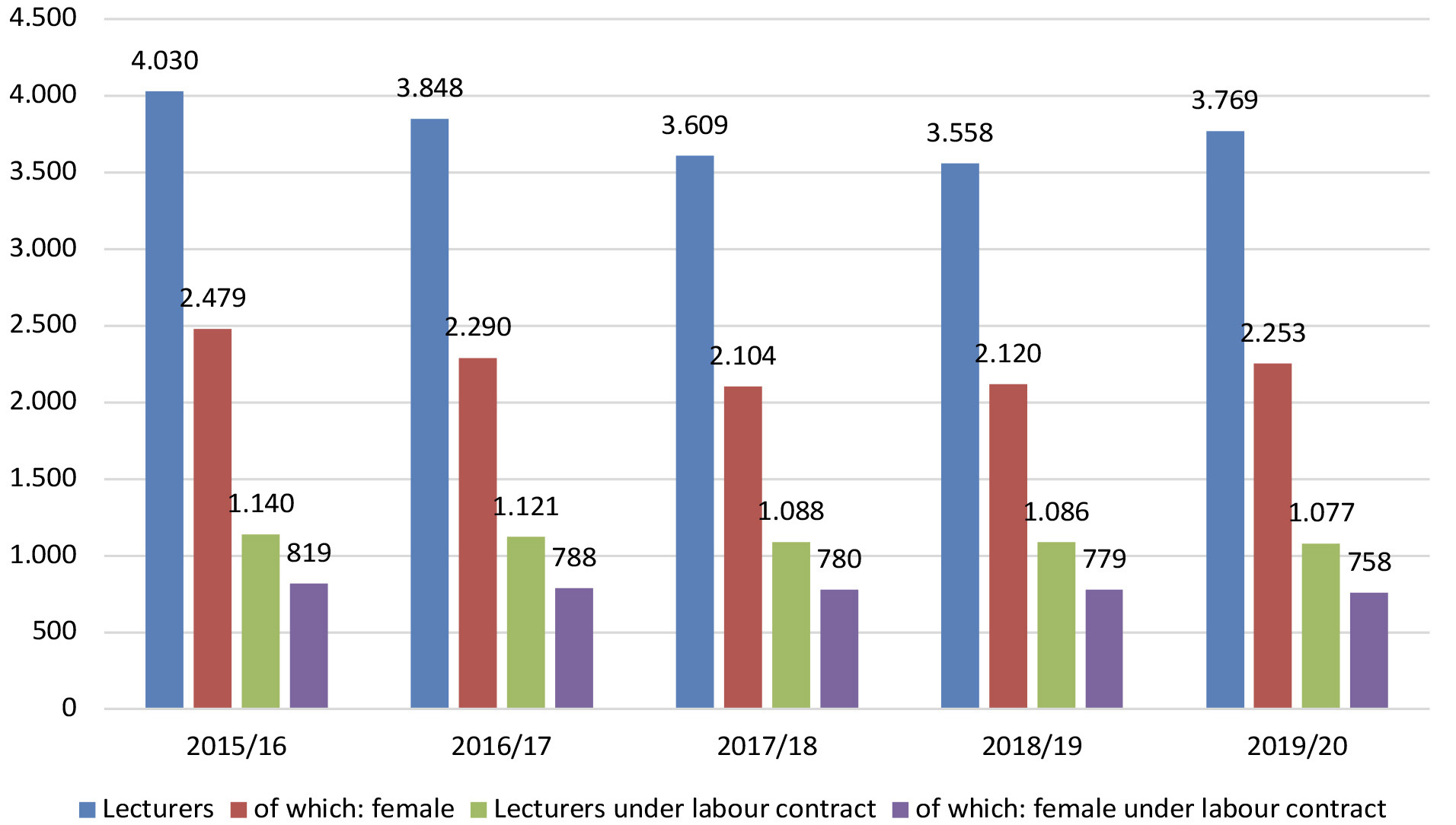
Figure 11.
Researchers in public and private higher schools
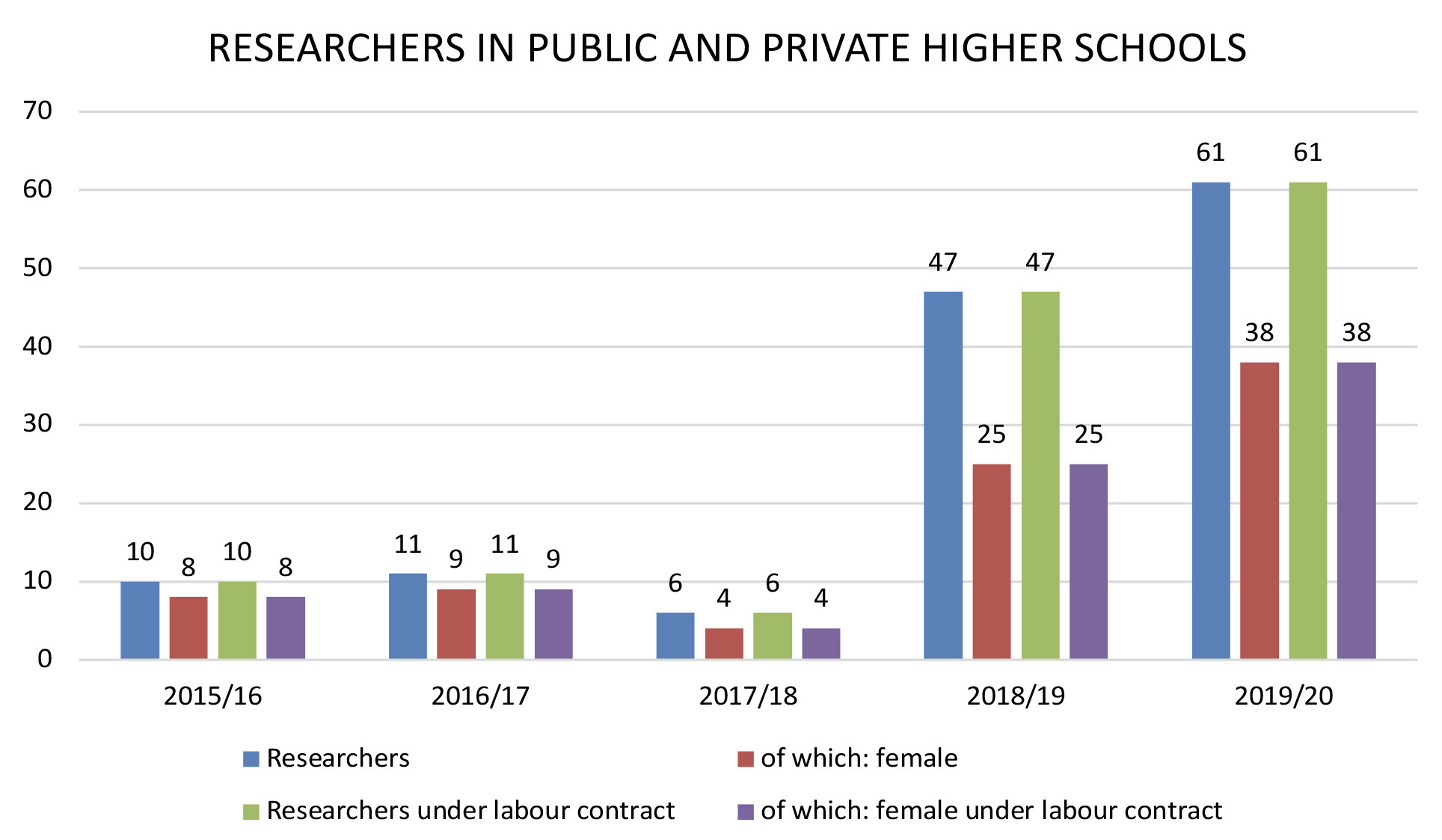
Decent Work measurements and monitoring is high in the agenda of International Labour Organization (ILO). Decent Work Indicators Framework covers ten substantive elements, which were starting point to define working set the indicators. “Employment opportunities for personal and professional development” is an indicator with a high rank within accepted emerging set of Decent Work indicators. Research team begins investigation to explore this indicator within area of science and university education and involvement of women.
This paper presents initial data for Bulgaria Higher education system. Official data from NSI, Bulgaria, shows that for the period of 5 years between 2015 and 2020 female students are more that 50% and female academic staff in total is about 50%.
Future research of research team within Decent Work network, coordinated by University of Malaga, Spain, is anticipated to collect, analyze and compare data for partner universities. Summary of results would draw fuller picture and would contribute to clarifying Decent Work indicator “Employment opportunities for personal and professional development”.
Nacheva-Skopalik, L.: “Evaluation of decent work using emerging set of indicators”, II international workshop on decent work and the future of work, 7-8 of May, 2018, University of Malaga.
Nacheva-Skopalik, L.: “Investigaciоn piloto para definir las prioridades del conjunto incipiente de indicadores de trabajo digno”, Revista Internacional y Comparada de Relaciones Laborales y Derecho del Empleo, vol. 8, núm. 3, 2020.
Момчилов, Д.: Българите! Забравените постижения, Ciela, Sofia, 2017.
[1] http://www.ilo.org/global/topics/sdg-2030/lang--en/index.htm, http://www.ilo.org/global/lang--en/index.htm, www.ilo.org/global/topics/decent-work/lang--en/index.htm.
[2] https://www.ilo.org/global/meetings-and-events/campaigns/voices-on-socialjustice/WCMS_099766/lang--en/index.htm, https://www.ilo.org/integration/themes/mdw/WCMS_123804/lang--en/index.htm.
[3] Nacheva-Skopalik, L.: “Investigación piloto para definir las prioridades del conjunto incipiente de indicadores de trabajo digno”, Revista Internacional y Comparada de Relaciones Laborales y Derecho del Empleo, vol. 8, núm. 3, 2020 y Nacheva-Skopalik, L.: “Evaluation of decent work using emerging set of indicators”, II international workshop on decent work and the future of work, 7-8 of May, 2018, University of Malaga.
[4] Nacheva-Skopalik, L.: “Investigación piloto para definir las prioridades del conjunto incipiente de indicadores de trabajo digno”, Revista Internacional y Comparada de Relaciones Laborales y Derecho del Empleo, vol. 8, núm. 3, 2020 y Nacheva-Skopalik, L.: “Evaluation of decent work using emerging set of indicators”, II international workshop on decent work and the future of work, 7-8 of May, 2018, University of Malaga.
[5] https://bg.wikipedia.org/wiki, http://bit.ly/3v9p24S, https://nauka.bg/nachalo-devicheskoto-obrazovanie-cveta-krastenyakova-1825-1919-2/.
[6] https://bulgarianhistory.org/anastasiq-dimitrova/, https://impressio.dir.bg/izgubenata-balgariya/anastasiya-dimitrova-parvata-balgarska-uchitelka, http://www.desant.net/show-news/53051.
[7] https://bg.wikipedia.org/wiki/, https://bit.ly/3hHIClH, http://bit.ly/3veuZ0c, https://www.europeana.eu/.
[9] https://nauka.offnews.bg/news/Novini_1/Koia-e-parvata-zhena-prepodavatel-v-Balgarski-universitet_73268.html.